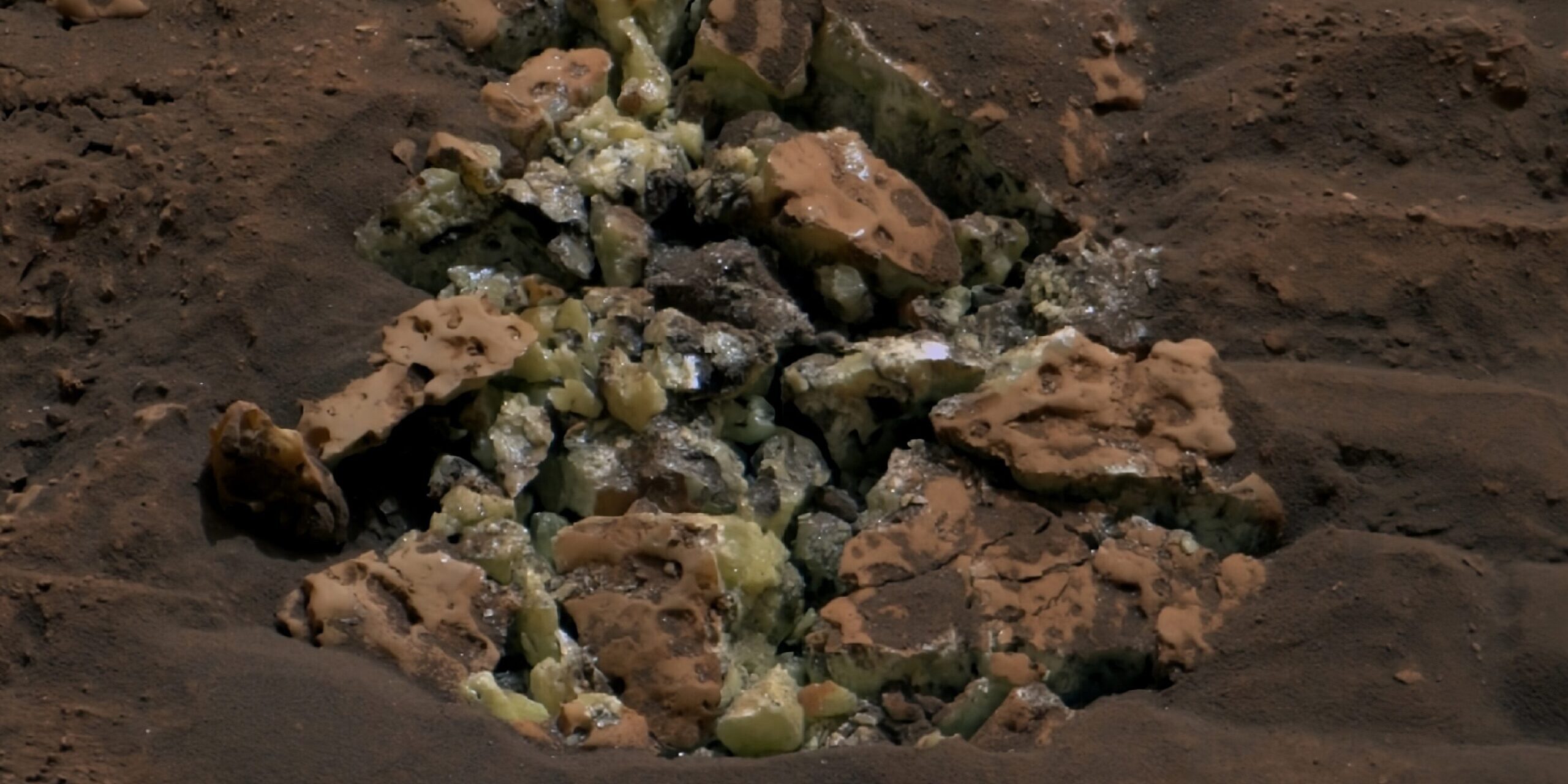Discovery of pure sulfur on Mars: Curiosity rover discovers yellow crystals in Geddis-Wallis channel, providing new insights into Martian geology and possible living conditions.
Surprising discovery: Mars rover Curiosity runs over a rock that’s broken and sulfur crystals are visible.
Photo: NASA/JPL-Caltech/MSSS
NASA’s Curiosity rover has been exploring the surface of Mars for more than a decade and continues to make new scientific discoveries. But the latest discovery trumps many things: The rover found pure sulfur in the Geddis-Vallis Canal. A coincidence led to this discovery when Curiosity ran into a rock and broke up. Inside, scientists found yellow crystals made of elemental sulfur – a first on the Red Planet.
Pure sulfur on Mars – a novelty
Sulfates are already known on Mars, which are compounds of sulfur with other substances. Sulfates form as salts when water evaporates and provide insights into the planet’s water history. However, pure sulfur, found in its elemental form, represents a new dimension to Martian geology.
Curiosity project scientist Ashwin Vasavata describes it well: “Finding a rock made of pure sulfur is like finding an oasis in the desert.” Pure sulfur is formed only under certain conditions that have not yet been achieved. The region of Mars around the Gediz-Vallis Canal is unknown.
Importance of discovery
The discovery of pure sulfur on Mars raises many questions. Sulfur is an essential element for life, as it is needed in the form of sulfate to produce essential amino acids. The discovery could provide clues about past conditions that may have supported life on Mars. How the sulfur got there is still unclear. The researchers suspect that currently unknown chemical processes may have played a role.
It is important to understand that sulfur is an essential element for all living things. On Earth, sulfur is mostly absorbed in the sulfate form and used to make two essential amino acids needed for protein synthesis. The discovery of pure sulfur will now help better understand geological and possible biological processes on Mars.
The Geddis-Vallis Canal: A Treasure of Mars History
Since 2023, Curiosity has been actively exploring the Geddis-Vallis Channel, located at the base of Mount Sharp. Each layer of this mountain tells the history of Mars. The channel is formed by the flow of liquid water and debris. This is particularly interesting because the presence of water indicates potential habitat. Previous research suggests that both floods and landslides have shaped today’s landscape.
The Gediz-Vallis Channel was discovered years before Curiosity was launched from space, and was one of the main reasons the science team wanted to visit this part of Mars. Since Curiosity’s arrival at Gully earlier this year, scientists have been studying whether the large debris rising from the canyon here was created by ancient floods or landslides.
Curiosity’s latest findings suggest that both played a role: some piles may have been created by massive water and debris, while others appear to be the result of more localized landslides. These conclusions are based on the rocks found in the debris piles: while rocks carried by water currents are rounded like river bedrock, some debris mounds are interspersed with angular rocks deposited by dry avalanches.
Further investigations are planned
The discovery of sulfur was only possible because Curiosity accidentally ran into the rock and broke it open. Although the sulfur rock is too small and brittle to drill, the rover was able to collect and analyze samples. However, a nearby large rock known as “Mammoth Lakes” provided enough material for detailed analysis.
How pure sulfur plays into the laborious and highly energetic assembly of the Mars puzzle remains uncertain at present. But researchers have high hopes for a yellow treasure that Curiosity might have found, so they want to take a closer look. Analysis of the samples is still pending.
Curiosity will continue to explore the Gediz-Vallis Channel and discover many more surprises along the way. This mission is a milestone in the exploration of Mars and an important step towards better understanding our neighbor planet.
Here goes Original report from NASA’s Jet Propulsion Laboratory.

